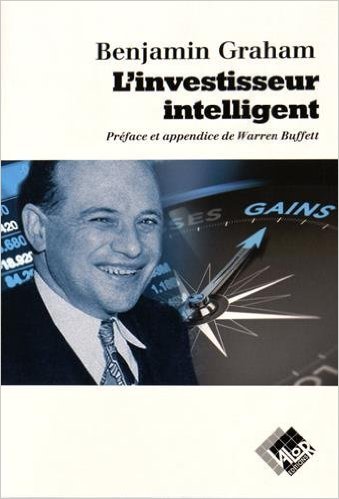
Ca y est, j’ai fini (en anglais) The Intelligent Investor du très connu Benjamin Graham, investisseur du 20ème siècle reconnu mondialement et qui a notamment été le mentor de Warren Buffet. Alors certes, ce genre de bouquin vous fait rêver de fortune ce qui est utopique pour un SMICard ou même un employé avec des revenus dans la moyenne sans se plonger dans un max de documentation, y passer tout son temps, y laisser un max d’énergie et surtout bénéficier d’un peu de « chance ».
Mais certains préceptes sont immuables et valent le détour. Un bouquin passionnant bien que très technique duquel j’ai sorti pas mal de « billes » pour bâtir ma stratégie d’entrée et sortie sur les marchés avec mon PEA et mon CTO.
Voici quelques points clés que j’ai pu en retenir :
-
Pas besoin d’être un matheux pour réussir en bourse, c’est même l’inverse. Plus on compexifie ses « screeners » avec tout un tas de courbes et d’indicateurs, plus on a de chances de se planter. Je confirme, mes résultats sont meilleurs depuis que je me contente de la courbe des prix, des volumes, du RSI et en appoint de la MACD… et c’est tout !
The point I want to make here is that there is a special paradox in the relationship between mathematics and investment attitudes on common stocks, which is this: Mathematics is ordinarily considered as producing precise and dependable results; but in the stock market the more elaborate and abstruse the mathematics the more uncertain and speculative are the conclusions we draw therefrom. In forty-four years of Wall Street experience and study I have never seen dependable calculations made about common-stock values, or related investment policies, that went beyond simple arithmetic or the most elementary algebra.
-
Benjamin Graham aborde l’aspect psychologiques des trades avec brio. Comme il dit, le risque ne réside pas dans les actions, mais dans nous-même.
The Risk is Not in Our Stocks, But in Ourselves
-
Il faut avoir le courage de son savoir et son expérience, c’est à dire se tenir à ses scénarios même quand la foule dit le contraire, elle a souvent tort ! Un bon scénario comprend un point d’entrée et surtout, SURTOUT, un ou plusieurs points de sortie. Il faut s’y tenir sous peine de perdre gros et gagner petit !
“Have the courage of your knowledge and experience. If you have formed a conclusion from the facts and if you know your judgment is sound, act on it—even though others may hesitate or differ.” (You are neither right nor wrong because the crowd disagrees with you. You are right because your data and reasoning are right.) Similarly, in the world of securities, courage becomes the supreme virtue after adequate knowledge and a tested judgment are at hand.
-
Il ne faut pas espérer qu’une action va monter (ou ne pas baisser) mais avoir calculé mathématiquement (à l’aide de logiciels par exemple) la prise de risque et l’accepter.
For the enterprising investor this means that his operations for profit should be based not on optimism but on arithmetic. For every investor it means that when he limits his return to a small figure—as formerly, at least, in a conventional bond or preferred stock—he must demand convincing evidence that he is not risking a substantial part of his principal.
- Faire du trading intraday (=acheter et vendre une action la même journée), c’est aller à la cata. Bien sûr une sortie de position suite à invalidation précoce de son scénario ne compte pas comme du trading intraday ;)
As we’ve already seen, day trading—holding stocks for a few hours at a time—is one of the best weapons ever invented for committing financial suicide. Some of your trades might make money, most of your trades will lose money, but your broker will always make money.
- Benjamin Graham explique la stratégie du Dollar Cost Averaging, ou comment entrer en position en plusieurs fois pour lisser le PRU et ainsi éviter de rentrer dans la phase haute du marché et le voir se casser la figure sans avoir de liquidités pour renforcer. Passage très très enrichissant.
The New York Stock Exchange has put considerable effort into popularizing its “monthly purchase plan,” under which an investor devotes the same dollar amount each month to buying one or more common stocks. This is an application of a special type of “formula investment” known as dollar-cost averaging. During the predominantly rising-market experience since 1949 the results from such a procedure were certain to be highly satisfactory, especially since they prevented the practitioner from concentrating his buying at the wrong times.
- A tout moment il faut savoir faire la différence entre spéculation et investissement.
There is intelligent speculation as there is intelligent investing. But there are many ways in which speculation may be unintelligent. Of these the foremost are:
(1) speculating when you think you are investing;
(2) speculating seriously instead of as a pastime, when you lack proper knowledge and skill for it; and
(3) risking more money in speculation than you can afford to lose.
- Suivre le marché, c’est mal. Contrairement à ce que tout le monde dit partout. Vous risquez de vous positionner en haut de vague et au mieux gratter quelques %, au pire faire une moins-value abyssale. Privilégier les retournements de tendance. Donc observer les actions en tendance baissière et attendre des signaux de retournement haussier avéré.
In our own stock-market experience and observation, extending over 50 years, we have not known a single person who has consistently or lastingly made money by thus “following the market.” We do not hesitate to declare that this approach is as fallacious as it is popular.
A lire absolument si vous vous intéressez aux finances personnelles et à l’investissement en actions / obligataire.
[Benjamin Graham – The Intelligent Investor]


